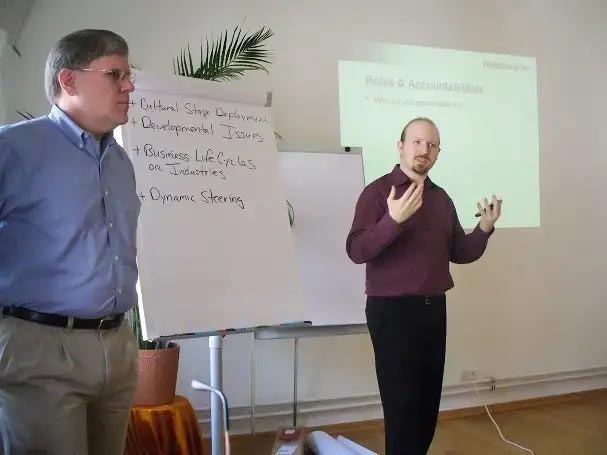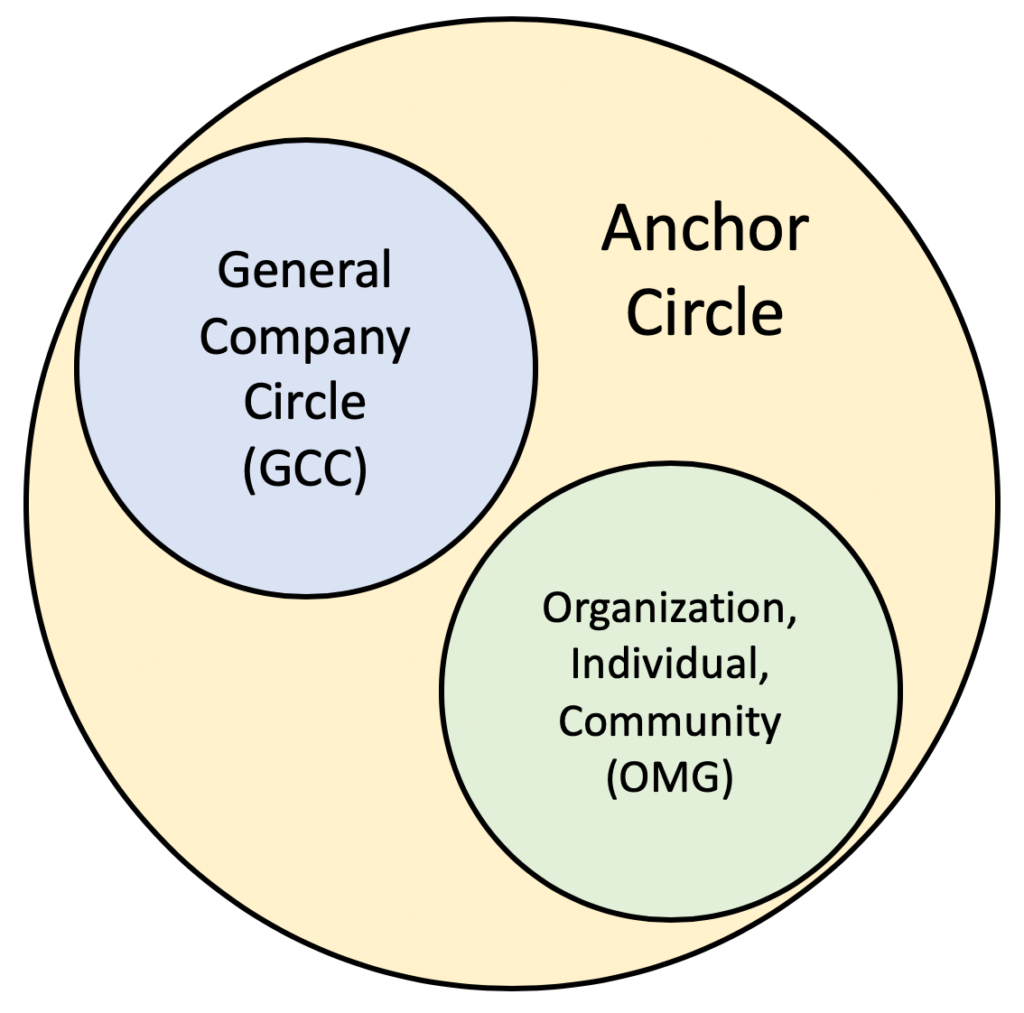
The OMG Circle App („Organisation, Mensch, Gemeinschaft“) v2.0
This Governance application is designed to address a common tension that is experienced when working within a Holacracy®-powered company. By separating “role” and “soul” and offering a clear home for the work to live in circles and roles, practicing Holacracy inevitably raises the question of what to do with people- and community-related matters. Where can those kinds of tensions be addressed? Clearly, without people energizing the organizational roles, we wouldn’t get work done. And where there’s two or more of them (us!) coming together, questions of interpersonal matters, cultural expectations, norms, and values, as well as the management of the relationship between the individual and the organization need to be consciously dealt with. Where do these kinds of tensions find a coherent home so that they can be resolved in a healthy way?

The following Governance app was developed in the context of Hypoport, a German fin-tech company. German labor law requires companies to enact certain duties of care for Employees (“disziplinarische Führung”- disciplinary supervision) which need a home as well. By making “Disciplinary Supervision” a domain on the OMG circle, it is easier to separate out the work of Lead Links from the work that is done in the role of “Disciplinary Leader” (“disziplinarische Führungskraft”). These functions, formerly merged in the person of the manager, can now be differentiated and distributed to different people under Holacracy. This supports the decentralization of power while it is at the same time in compliance with German labor law.
The app is building on top of ideas from similar solutions at HolacracyOne (“People & Partnership Circle”) and encode.org (with its differentiation between “Organziation” and “Association” container). It proposes to create a circle parallel to the General Company Circle dedicated to mediating the needs between Organization (“Organisation”), the Individual (“Mensch”) and the Community of people (“Gemeinschaft”) — OMG for short.
Oh my god, this German acronym is awesome! So, let’s keep it for the English version. 🙂

The advantage, as we see it, is that the OMG circle construct can harbor all the work which is not directly related to the core business functions of the organization and its purpose. Those live in the GCC. Rather, the OMG becomes the home of the kind of work that creates the necessary pre-conditions and holding context for people, enabling them to show up meaningfully as role fillers in service of the purpose of the organization in the first place. The OMG is an interface that makes working within a holarchy of organizational purpose a more human experience.
In its second iteration (v2.0), the app features the domain of “Global Policies” that authorizes the OMG Circle to pass policies that are globally binding company-wide even though it is technically still a sub-circle to the Anchor Circle.
Policy for the Anchor Circle:
Circle: OMG (“Organisation, Mensch, Gemeinschaft”- Organization, Individual, Community)
The organization separates its core functions of value creation from its non-core functions in order to give both of these needs the necessary attention in different contexts. The core value generating functions lie in a special General Company Circle (GCC), which enacts the purpose of the organization. All of the non-core functions, especially the accountability to build and maintain a pool of talents, lies in a special circle, the OMG Circle (“Organisation, Mensch, Gemeinschaft”- organization, individual, community). The OMG circle controls (as a domain) the relationship of the organization to every Employee. The Organization may add, terminate, govern, or redefine these relationships as it sees fit, within the constraints below.
The OMG Circle must be created within the Anchor circle next to the GCC and support the overall purpose of the organization. The definition of the OMG circle is as follows:
Purpose
Well mediated needs between the organization, the individual and the community
Domains
- Employment Contracts
- Working Agreements
- Disciplinary Supervision
- Global Policies
Accountabilities
- Creating an inspiring work environment with suitable work equipment
- Covering the demand of the organization for qualified Employees (e.g. via recruiting and development)
- Enacting the legally required duties of care for Employees (disciplinary supervision)
- Providing an opportunity for Employees to process their individual and collective tensions themselves or via an elected representative within the OMG circle
- Creating, setting and redefining Employment Contracts and salary for the Employees
- Fostering the community of Employees and offering support for resolving tensions in the individual or collective space
- Providing a frame for documentation of Working Agreements
Employment Contracts
The relationship between an Employee and the Organization will typically include mutual agreements to entice each party to enter and remain in the relationship, such as agreements around compensation, expected travel, or time an Employee will focus within the organization (altogether the “Employment Contract”).
Either the Employee or the Organization may modify their Relationship Contract, but only by making a proposal to the other party. The recipient may then either accept the proposal, or decline by sharing an Objection given their own Purpose or Accountabilities. The OMG Circle may define Roles or processes for initiating or processing these proposals on behalf of the Organization.
Company-wide validity of Policies created by the OMG Circle
The OMG Circle is authorized by the Anchor Circle to create policies that are valid company-wide. Hence, its policies may govern the GCC and its sub-circles as well as itself and its sub-circles. This global authorization obsoletes the need for duplicating Policies created by the OMG Circle in the Anchor Circle in order to make them binding for every circle. In order for a Policy of the OMG Circle to claim company-wide validity, it has to be assigned to the Domain “Global Policies”. This right can be passed on to sub-circles of the OMG Circle, by explicitly assigning the Domain “Global Policies” to a sub-circle. Such sub-circles may henceforth define Global Policies like the OMG Circle.
Working Agreements:
From time to time, the Organization’s Employees may desire certain agreements about how Colleagues will interact with each other or fulfill their general functions as Employees or Circle Members (Policies don’t work for such agreements since they can only govern roles, not unilaterally impose behavioral demands on people). These “Working Agreements” are for shaping the cultural environment and collegial behaviors that underpin Role-based work. They may only define expectations beyond the scope of what adding an Accountability on a specific Role can achieve, such as defining norms that are relevant across many Roles or regardless of Roles, or shaping when or how a Colleague allocates time or energy to a Role. Working Agreements must focus on concrete acts to do or behavioral constraints to honor; they may not include promises to achieve specific outcomes.
Any Colleague may request a Working Agreement of another Colleague. The request becomes a legitimate expectation only if the other Colleague accepts the agreement, and only after a relevant party publishes it in a location referenceable to any stakeholder. A Colleague who has made a Working Agreement may terminate it at any time, by giving notice to all affected parties and striking the agreement from the published record (or requesting an appropriate role do so). This termination does not require the consent of any other party or stakeholder to the agreement unless the agreement is included in the Employment Contract.
The OMG Circle may choose to require acceptance of a Working Agreement as a condition of employment in the Organization, and thus making it part of the Employment Contract with all Employees. However, adopting such a Policy never automatically conveys that agreement upon current Employees, and nor does it automatically terminate a current Employee who declines to accept it. Even if a Working Agreement is required for new Employees, each existing Employee must still explicitly accept the new agreement before anyone has a legitimate right to expect it of that Colleague.
Inspirations: HolacracyOne’s People & Partnership Circle, Brian Robertson’s “Partnership Circle & related rules”, encode.org’s For-Purpose Enterprise construct (Organization, Association, Company)
Contributors: Klaas Reineke, Dennis Wittrock, André Maennicke (Hypoport)
“Holacracy Apps are prepackaged governance proposals designed to work within organizations running Holacracy. Apps allow organizations to distill and share governance proposals to address common organizational issues like talent management (e.g. hiring, firing, compensation), operations (e.g. strategic planning, supply-chain logistics, resource allocation), and organization design (e.g. new regional divisions, mergers and acquisitions, expansion). Please also note that Holacracy apps are only suggested governance proposals and may be modified before or during governance meetings depending on the user’s needs.”
— Holacracy Community of Practice
To learn more about self-management, join a community of pioneers and check out our e-learning suite → Self-Management Accelerator